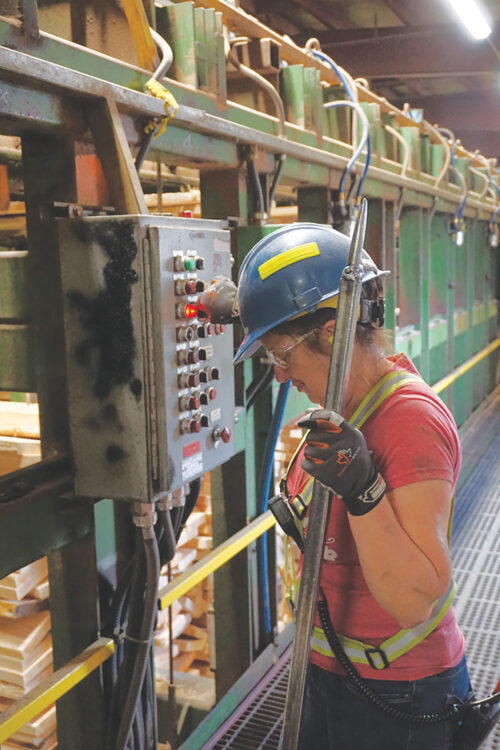
Industry News
News
Retirements add to forestry labour woes
To address the situation, Ontario organizations partnered to create the Bridge the Gap research project to find solutions
February 7, 2023 By Sandi Krasowski, Local Journalism Initiative Reporter
 Photo: Annex Business Media.
Photo: Annex Business Media. Labour shortages caused in part by a large portion of the workforce retiring without the ability to replace them is being felt by industries across the country with the forestry sector being no exception.
The labour and skill shortage faced by the forestry sector is preventing it from realizing its full economic potential, according to Ontario’s Ministry of Natural Resources.
They say it could negatively impact the socio-economic standing of hundreds of communities across the province of Ontario for years to come.
To address the situation, Ontario Forest Industries and Forests Ontario partnered to create the Bridge the Gap research project to find solutions.
Started in March of 2021, the project ran until November of 2022 and resulted in the exploration of new partnerships and opportunities to implement recommendations to help address the ongoing shortage.
Ian Dunn, president and chief executive officer of Ontario Forest Industries, says a gap is caused by low awareness and negative perceptions that prevent some youths from considering a career in the industry.
“Those are significant barriers to recruitment,” Dunn said. “In Ontario, there is a large urban-rural divide. In Thunder Bay, there are a lot more people exposed to the forest industry when you compare it to the (Greater Toronto Area) in southern Ontario.”
He added, a very interesting finding of the study was when respondents were provided with more information about the industry, generally their perception of working in it improved.
Allison Hands, an education manager with Forests Ontario, said a range of educational programs, training and support initiatives exist across Ontario to train forest sector workers, however gaps in standardization and consistency can present challenges.
“Training and education for some woodland sector jobs are limited geographically to (Greater Toronto Area) and southern Ontario, which in turn can limit youth exposure to forest career pathways,” she said.
“We’ve seen this time and time again, Dunn noted. “The more you learn about this industry, the more likely you are to support it and get involved in it.”
He says there are also negative perceptions about the sector that are typically focused on environmental impacts.
“The thought of cutting trees for some people is enough for them to not consider a career in the industry, but this is a renewable sustainable resource here in Ontario. We have world-class forest management practices. As we start educating the respondents about our program here in Ontario, the more likely they are to consider it.”
Top benefits that they’ve identified from people working in forestry is that it’s an industry that aligns with their values.
“They enjoy the work and they overwhelmingly believe that the work they do has a positive impact on the environment, and that is obviously in contrast to what the general public thinks,” Dunn said.
“Also the lifestyle it provides, in terms of affordable housing, opportunities to get outside and enjoy the great outdoors. It’s good salary and the impact that it has on its local community.”
A provincial forest sector strategy released in 2020 aimed to fully utilize Ontario’s annual allowable cut every year, which meant doubling what they currently harvest in the province to be successful in that.
“There’s a number of things that need to be in place, from forest management, planning, forest operations, hauling to the mill, mill operations, and then ultimately selling the products at market,” Dunn said.
“Each one of those areas faces a challenge in terms of workforce, so we’re only going to be successful in this strategy if we have the workforce in place to actually achieve these goals. Currently, it is a bottleneck and it’s preventing the forest sector from fully achieving its potential — contractors, logging contractors, roadbuilding, and truck drivers — there’s a massive shortage right across North America. It’s not that the mills won’t consume the material, it’s that they can’t get it to begin with. It’s a real challenge.”
Also challenging for recruiting people in northern and rural communities across Ontario is the livability, with challenges finding medical care, daycare, affordable housing, and broadband access.
“We want to work with the Ontario government insurance companies and there are huge barriers to entry – particularly for truck drivers in this province,” Dunn explained. “There are very qualified people coming from foreign countries who are caught up in licensing requirements and we hope to remove that red tape for those foreign credentials and have them start working in our industry.”
Dunn added that crucial projects such as the Thunder Bay Community Economic Development Commission’s Northern Immigration Pilot holds a lot of promise and partnerships with Indigenous communities which are important to the sector. Mills are partially or entirely owned by First Nation communities and some have tenure over the resource.
“We see the Indigenous communities as really the future of our workforce and there are all kinds of opportunities there,” he concluded.
Sandi Krasowski is a Local Journalism Initiative reporter for The Chronicle-Journal.
Print this page